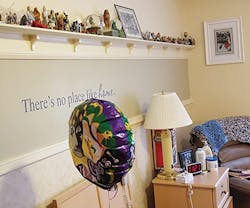In all types of healthcare settings, health and well-being have always been the goal—utilizing evidence-based design principles
(www.healthdesign.org), supportive research, and measurable outcomes. An integrative design process (functional programming) is key to sustainable success for complex healthcare projects—not only from a green building perspective, but also from a sustainable care model, business model, and a return-on-investment point of view. After visiting the global offices of CBRE—the first company to achieve a WELL-certified project—in Los Angeles, it is apparent that there is a new culture brewing based upon the WELL Building Standard® requirements. Further, as demonstrated at Greenbuild, there is a new industry of consultants and assessors that are being used to further develop, design, and certify buildings and operations utilizing the standard.
After visiting CBRE and reflecting on my own healthcare practice, the one thing that was very clear to me was the lack of individualization for staff utilizing the spaces. A few years ago, I proposed to my staff that we should try to use office stations designated by project and have each design professional move from each station to work on projects, as required, either as a team or individually. Being that everything was electronic with information on servers, a person could work from any location. I was firmly told “no” by my staff as they had a sense of ownership within their own workspace. Further, each person has an identity—things that allow them to creatively express themselves. When we work on healthcare projects that include extended patient stays or long term care settings, we encourage patients, families, and residents to express themselves as unique people. The bulletin boards in our office have been covered with interesting designs and products, pictures of family members, and in some cases images that provide comic relief in the daily routine. There is color and texture—a woven “fabric” that reflects an individual’s personality—acting as inspiration.
We are currently working on the relocation of our office after being displaced by a 1,000-year flood and we are considering Green Globes Sustainable Interiors certification (www.thegbi.org). If I am going to apply the WELL Building Standard® to our office or any new project, I would design a “human-centered toolbox”—one that allowed someone to make their personality portable—reflecting his/her lifestyle, celebrating uniqueness, and fostering inspiration. We have strived to create a human-centered approach to design that supports our “human-ness,” and does not neutralize or stifle it within traditional institutional settings. Is there not a balance between the workplace environment and celebration of individuality? We strive for human-centric environments within healthcare settings that encourage positive behaviors directed toward wellness, refining staff performance outcomes, and ultimately improving patient and resident outcomes. A wellness approach in healthcare is inclusive of sustaining the opportunities for residents, family members, and patients to express themselves and be recognized as individuals with
differing needs while receiving their care and support.
Jane Rohde is the founding principal of JSR Associates, Inc., located in Ellicott City, Md. She champions a global cultural shift toward de-institutionalizing senior living and healthcare facilities through person-centered principles, research and advocacy, and design of the built environment. Clientele includes non-profit and for-profit developers, government agencies, senior living and healthcare providers, and design firms. Rohde speaks internationally on senior living, aging, healthcare, evidence-based design, and sustainability. For more information or comments, please contact Rohde at [email protected].
Student Profile
Tatiana Epimakhova
MS in Architecture + Health at Clemson University; Fulbright Scholar and Alumna from Russia
Project Description
I have had the distinct pleasure of working with Epimakhova on her thesis project that explored planning and design strategies that create an inclusive environment for the elderly—designing a community that integrates various generations for mutual support for all ages. The aim of Epimakhova’s research was to define design strategies as tools for creating a community for old and young generations in the U.S., and apply them through the development of a conceptual project. Seven imperative guidelines were developed based on a literature review and analysis of the best design practices of multigenerational communities in the U.S. and Europe. A community becoming a positive intervention—this is the future for healthcare and senior living.
About the Author

Jane Rohde
AIA, FIIDA, ASID, ACHA, CHID, LEED AP BD+C, GGA-EB
Jane Rohde, AIA, FIIDA, ASID, ACHA, CHID LEED AP BD+C & GGA – EB: Jane Rohde is the founding principal of JSR Associates Inc. in Catonsville, MD. JSR Associates Inc. celebrates 23 years of consulting services in 2019. Jane is the recipient of the 2015 Environments for Aging Changemaker Award and in 2018 she received the ASID Design for Humanity Award, was recognized as an Honorary Alumni of Clemson University’s Architecture + Health program, and has been honored as one of 10 notable Women in Design. For more information or comments, please contact Jane Rohde at [email protected] or “Chat with Jane” at www.jsrassociates.net.
